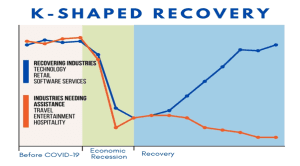THE STATE OF THE INDIAN ECONOMY TODAY
THE CONTEXT: As, the state of the Indian economy and its prospects have to be based on mathematics and statistics, the recently published data by National Statistical Office needs to be analysed. This helps to understand the government’s economic performance as disclosed in Parliament and subsequently published in the media.
ISSUES:
- Misleading data: Post-COVID-19, the growth rate of GDP has been estimated around 6% + annually but this is misleading because what is not disclosed is that the growth rate that includes recovery as well since 2020-22. Hence, if we calculate the GDP growth rate between 2019-20 and 2022-23, two normal years, it can be calculated less than 4% per year for the period.
- Non acknowledgement: India’s GDP growth rate declined annually from 2016-17, and fell below 3.5% in the fourth quarter of 2019-20. This four-year continuous decline from a 7% growth rate to 3.5% rate has never been acknowledged by the government.
- Slow growth rate: It is essential to recognise that since 2020, the current government publicised development model in reality achieved the so-called “Hindu rate of growth” in GDP, which had been “achieved” during the Congress’s socialist period of 1950-77.
- Incoherence in economy: The ruling government has failed to structure economic policy coherently. Incoherence prevailed during the 2014-2023 period and will perhaps continue in the future as well.
- Misleading media: The misleading announcements of promising predictions are being published annually in the media, with claims made by the ruling government. One such claim made in 2019 was that India will become a $5 trillion economy by 2024. There has been no policy structuring presented to achieve this aim nor has anyone in the government shown willingness to debate it on public fora.
- Falling investment: The investment to GDP ratio has been largely falling for many years now. It peaked at 35.81% in 2007–08, which was 15 years ago. In 2022–23, it is estimated to have been 29.21%, an improvement over the three years before that, but worse than where it was before the pandemic broke out.
- Lesser job creation: Falling of investment in the economy implies the creation of fewer jobs, which has an impact on the incomes that people earn, and which, in turn, affects private consumption and further job creation.
THE WAY FORWARD:
- Taking cue from previous governments: During P.V. Narasimha Rao’s and Manmohan Singh’s tenures as Prime Minister, India departed from the socialist path and the GDP growth rates rose for the first time to 6%-8% per year and over a 15-year period i.e., between 1991-96 and 2004-2014. As, then government understood and took steps to reform the Indian economic system by reducing state participation, and increasing incentives for capital and labour providers and achieved a higher and faster growth rate.
- Transparency: The Indian government is elected democratically and it is obligated to disclose the facts and data transparently to the people.
- To generate demand: In this decade of weak demand and relatively excess supply, resources mobilised by the government should be largely through indirect taxes and also through the liberal printing of currency notes to generate demand from non-rich citizens.
- To generate non inflationary demand: The annual interest paid on fixed-term savings in the bank accounts of the middle class should be higher at 9% or so. The interest rates on loans issued to small and medium industries should be no more than 6% on the loans. These essential reforms need to be carried out to generate non-inflationary demand.
- A new economic policy: The recent economic policy of the government has been an unstructured flop. No announced macroeconomic goal has been achieved by the government till date. Thus, India urgently needs a new economic policy that is based on clearly structured and stated objectives and priorities, and a strategy to achieve the targets, with an intelligent and transparent resource mobilisation plan to finance the policies.
- Free market system: The market system is not a free-for-all and is structured with rules of transactions. A market system with transparent and minimal regulation with principal drivers of incentives and domestic savings pushes up factor productivity and thus the GDP growth rate. Even a totalitarian state such as China implemented this. During Deng Xiaoping’s tenure as paramount leader, it allowed the socialist economic system to die, and allowed economic market-based system, even while maintaining the system of political dictatorship.
- Affirmative action: There is a need for affirmative action including social security and safety nets for creating a stake for the poor in the system. It will create a level playing field to ensure transparency, accountability, trusteeship as well as corporate governance to legitimise profit-making that will drive the market system.
- Empowering democratic institutions: Deregulation should also not mean that we reject government intervention for safety nets, affirmative action, market failures, and creating a level-playing field. Democratic institutions have to be empowered to guard against public disorder arising from rapid deregulation, as it happened in Russia post-1991. Russia underwent chaos and misery, which meant dictatorship returned a loss of human rights and democratic values in Russia.
THE CONCLUSION:
India’s economic growth has witnessed significant fluctuations in recent years and to ensure economic stability the government needs to take up stringent measures. This can be done through adequate investment in human capital development along with effective implementation and coordination among various stakeholders.
UPSC PREVIOUS YEAR QUESTIONS
Q.1 Define potential GDP and explain its determinants. What are the factors that have been inhibiting India from realizing its potential GDP? (2020)
Q.2 Do you agree with the view that steady GDP growth and low inflation have left the Indian economy in good shape? Give reasons in support of your arguments. (2019)
MAINS PRACTICE QUESTION
Q.1 The GDP-centric framing of Indian economic success is wrong-headed and is a flawed metric of national economic welfare. Comment.
SOURCE: https://www.thehindu.com/opinion/op-ed/the-state-of-the-indian-economy-today/article67838620.ece
